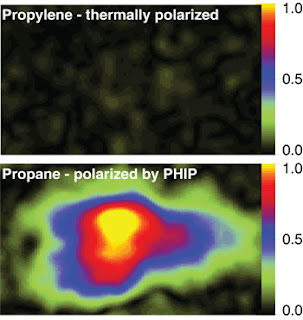“This is the first time hyperpolarized gas has been used to directly study catalytic reaction products on such a small scale and without the use of tracer particles or gas,” says Bouchard. “It opens the door for future studies of heterogeneous catalysis in which all the unique benefits of MRI, such as velocimetry and spatially dependent quantities, are available.”
At standard temperature and pressure, hydrogen gas exists in one of two molecular forms – ortho and para – with the former making up about 75-percent of the mixture. Both molecular forms are diatomic, but in orthohydrogen, the spins of the two protons in the nuclei are pointed in the same direction, whereas in parahydrogen, the spins of the two protons point in opposite directions. By increasing the fraction of parahydrogen in the gas mixture there is a net excess in the para spin state even at room temperature and in the complete absence of a magnetic field. Under the right conditions, this hyperpolarization can be passed on to other nuclei and used to substantially boost the strength of their MRI/NMR signals by several orders of magnitude.
Pines, Bouchard and Burt have found a way to use parahydrogen enhanced gas in combination with propylene gas and a heterogenized catalyst to achieve a strong MRI/NMR signal from samples in the gas-phase, something that has only been done before using hyperpolarized noble gases and expensive polarization equipment. A mixture of propylene and parahydrogen enriched gas (about 40-percent parahydrogen) is flowed through a reactor cell containing a catalyst (Wilkinson’s catalyst) that’s been immobilized on a modified silica gel. As the parahydrogen enhanced gas mixture passes over the catalyst, hydrogenation takes place. This produces spin polarized propane gas that is transferred to an MRI/NMR magnet. The catalyst-free hyperpolarized propane gas can then be used to enhance MRI/NMR signals.
“The enhanced MRI/NMR sensitivity provided by parahydrogen induced polarization allows us to overcome the inherent problem of low sensitivity in thermally polarized gas-phase MRI/NMR,” says Bouchard. “This is the reason we are able to get such high-spatial resolution MRI images in the gas phase. Using conventional thermally-polarized MRI/NMR signals, this would be an impossible task.”
It has been a persistent challenge for scientists and engineers who study catalysts to correlate active catalytic regions with overall morphology in heterogeneous catalyst beds. It has also been a challenge to monitor the multistep reactions that take place within the beds. This has hampered the design of catalytic reactors that give optimal performances.
Says Burt, “Our MRI/NMR technique provides the ability to directly measure the spatial dependence of conversion and allows one to do a reality check on any simulations or assumptions used to design a catalytic reactor. Design can therefore become an iterative process that converges on an optimal performance.”
The costs of researching and developing new catalysts can be very expensive, and the parahydrogen-enhanced MRI/NMR technique developed by Pines, Bouchard, Burt and their collaborators has the potential to significantly reduce these costs, as well as substantially speed up the process.
Not only does it allow future studies of potential catalysts to be carried out on a smaller and more economical scale, it is also well-suited for “green chemistry,” the new approach that seeks to maximize productivity and yield while minimizing costs, amounts of reactants and waste products.
Pines, Bouchard and Burt say their technique is ready to be used in the study of hydrogenation reactions now. In the future, they would like to extend its applications beyond hydrogenation to study other types of catalysts and chemical reactions.
Says Bouchard, “We also have new ideas on how to get high-resolution temperature and pressure maps of the catalyst bed that will convey information about the energetics of the chemical reaction and mechanics of fluid transport during the reaction.
Says Burt, “This would be very exciting as there are few existing techniques that provide such information apart from simulations. And for microreactors, there is simply no competing method for studying such gas-phase reactions at this level of detail and spatial resolution.”
This work was supported by the Director, Office of Science, Office of Basic Energy Sciences, Materials Sciences and Engineering Division of the U.S. Department of Energy.
Berkeley Lab is a U.S. Department of Energy national laboratory located in Berkeley, California. It conducts unclassified scientific research and is managed by the University of California. Visit our Website at www.lbl.gov.
Additional Information: For more information on the research of Alexander Pines and his research group, visit the Website at waugh.cchem.berkeley.edu/
Technorati Tags: Nano or Nanotechnology and Nanotech or Lawrence Berkeley National Laboratory and Microreactors or Why the web tells us what we already know and Chinese New Year of the Rat, Wu Zi, 4705 and Nanowires hold promise for more affordable solar cells or Harriet Tubman

















No comments:
Post a Comment